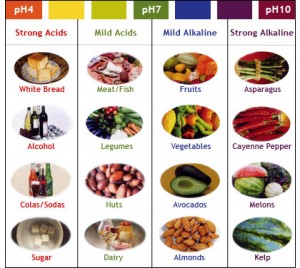Living in the South during the summer, one of my favorite sites is the array of hydrangea bushes, from their deep, grape purples to their bright, festive pinks and the powdery blue periwinkles. I don’t know much about growing flowers, but I do know that there is a trick to changing the color of the hydrangea blossoms by changing the pH of the soil.
Thinking about this lead me to ponder the pH of our bodies and how it impacts the color of our health. Grasping pH is not the easiest subject, so I’ve done my best to explain it as simply as possible so that we can all take full advantage of nature’s healthful ways.
Inner body environment pH (a measurement of the concentration of hydrogen ions; pH = potential of Hydrogen) is important and, in fact, crucial to human life and wellbeing. The pH scale slides from zero to 14. Neutral is 7, higher than 7 is alkaline, lower than 7 is acidic. For optimal health our bodies need a pH between 7.365 and 7.45…just slightly alkaline.
Why and How?
An acidic pH (a low ability to attract Hydrogen ions) can occur from acid forming foods, emotional stress, toxic overload or any process that deprives the cells of oxygen. The body’s ability to absorb minerals and other nutrients, the energy production of the cells, the ability to repair damaged cells, and the ability to detox heavy metals will all decline in an acidic environment.
Tumor cells will thrive and the body will become more susceptible to fatigue, illness, bone weakness, increased rate of blood clotting, heart disease, and a suppressed immune response in an acidic environment.
To restore and maintain optimal health with an alkalizing (a high ability to attract hydrogen ions) diet, a minimum ratio of 80% alkalizing foods to 20% acid forming foods is ideal. The mineral content of a food is the primary determining factor as to whether the food produces an alkaline or an acidic reaction in the body. Here is a VERY simplified chart:
You are able to find many acid and alkalizing food charts online and they will vary to a degree as food and body interaction is not an exact science, however most charts will show that raw fruits and vegetables – foods naturally abundant with the alkalizing minerals calcium, magnesium, sodium, and potassium intact – and most waters fall under the 7-10 (alkaline) range. Most grains, processed sugar, animal foods, nuts, fruit juices, coffee, drugs and alcohol fall in the 6-0 (acidic) range.
Interesting Facts:
- To neutralize a glass of cola with a pH of 2.5, it would take 32 glasses of alkaline water with a pH of 10.
- Human blood has a pH between 7.35 and 7.45 and even a tenth of a variation outside this range can result in death.
- Eating a diet high in meat creates an acidic internal environment. To alkalize the blood, the body will leach calcium from the bones, leaving the skeleton calcium deficient. Taking concentrated, isolated calcium in the form of supplements acidifies the blood and has been shown to increase heart attack risk.
- Cancer cells thrive in an anaerobic environment, meaning one where oxygen content is very low. Cancer cells starve in an alkaline environment.
I hope I’ve explained the concept of pH well for you. Please leave comment below this post on the blog if you have any pH tidbits or stories to add. I’d love to hear what alkalizing foods you’ll be adding to (or acidic foods subtracting from) your diet after reading this post.



{ 8 comments… read them below or add one }
Very interesting facts! I’ve never really been one to drink many colas but I do treat myself every once in a while. I never really understand why they were bad for you just knew that they were…great facts! 🙂
Ron | Active Planet Travels recently posted..A Spiritual Experience in Sedona
Interesting facts. I knew sodas were bad for you but this is shocking.
Thank you for this enlightening information. I wish I saw it earlier. But I’m glad I found it none the less. I am currently on a journey to cutting (refined) sugar out of my diet. I do enjoy fruits and vegetables, so the next step will be meats. I’m drinking more water and feeling better already. I can only imagine how good I’ll feel once I cut out sugar!
Nice work! Keep going and keep enjoying the additional perks of a cleaner, more healthful lifestyle!
Carla,
I take a small supplement with Tums to lower my acidity. But Tums do include sugar. I believe that the benefits of the alkalinity outweigh the dangers of sugar. Are there any other supplements for calcium and to build up alkalinity besides the natural organic foods or drinking lots of water? Maybe Calcium supplements without sugar?
Thanks for your comment and question Bill. I think to better answer your question I would need to get a bigger picture of your overall diet. Why do you need to reduce acidity? Are you consuming acid-forming foods and beverages (meat, dairy, sugar, refined grains/flour, alcohol, coffee, etc)? My first reaction is to encourage the reduced consumption of acid-producing foods and/or beverages in order not to need the Tums or other remedy in the first place. Leafy greens, sesame seeds, and tofu are great for calcium and they are on the alkaline end of the spectrum. Hope this helps! There are a couple of great images for alkaline calcium sources in the blog post HERE.
Regarding the interesting fact you have written, “Eating a diet high in meat creates an acidic internal environment. To alkalize the blood, the body will leach calcium from the bones, leaving the skeleton calcium deficient.”
I do not believe the above fact is true in isolation. Many people today follow the carnivorous diet which is mostly meat, eggs and fat. I think it could depend on the type of meat (grass fed vs grain fed), and people on high meat diets usually have high amounts of grain in their diets which is the main culprit.
It is my understanding that proteins are composed on amino acids which are….well, acidic in nature. Whether from grass-fed animals or grain-fed animals, muscle meat is predominantly protein, thereby amino acids. I agree that highly processed grains can contribute to acidity. Long-term studies on those adhering to a carnivorous diet are not yet available. It will be interesting to learn how these folks fair over numerous years. I’m concerned for them and their deficient intake of fiber.